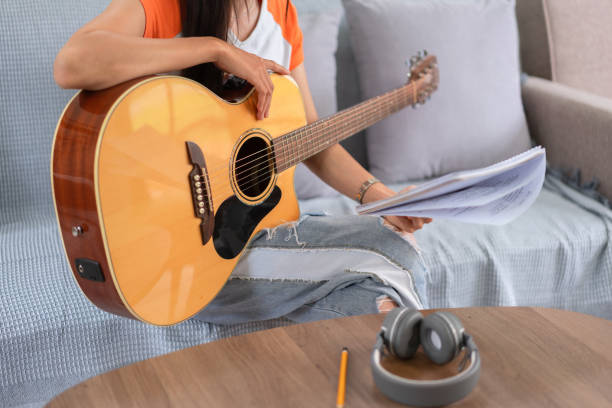
How to read guitar plucking chords
Education on how to read guitar plucking chords is a very important process in the training of any future performer guitarist. Whether it is the initial stages of learning music or choosing to add a new dimension to the already existing skills, knowing how to read and play plucking chords is undoubtedly very enlightening. In the following passages, we are devoted to offering detailed information and suggestions regarding how to read guitar plucking chords so that you will get well prepared for improving your guitar skills.
Explanation of Guitar Tablature
In order to get to know properly how to read guitar plucking chords, it would be constructive to learn the general knowledge of the so-called tab, or guitar tablature.
The Basics of Tab
The guitar tab uses six horizontal lines that each stand for one particular string of the guitar. The first new line on the next octave represents the high E string, and the primary new line in the next bass ledger signifies the low E string. These are the numbers on the fretboard that tell you what fret to play on that specific string.

How to read guitar plucking chords
So now that we’ve gone through the basics of playing tab, we are going to move on to how to read guitar plucking chords in particular. Arpeggios imply playing single strings of the chord in a sequential pattern and not using a pick to strike all the strings at once, as in the study.
Identifying Plucking Patterns
When learning chords on the guitar, you will find that there are patterns that show the order of which strings to pluck. These patterns are typically represented by letters or numbers beneath the tab:
In this example, the letters “p,” “i,” “m,” and “a” represent the fingers used for plucking:
- p: thumb (pulgar in Spanish)
- i: index finger (índice)
- m: middle finger (medio)
- a: ring finger (anular)
Common Plucking Patterns
When studying how to read guitar plucking chords, numerous common patterns are realized as you advance in your learning. Here are a few examples:
- Alternating bass: For the bass note, pluck it with the thumb; for the rest of the notes on the higher strings, use the fingers.
- Arpeggio: When playing chords, pick the strings in a particular sequence, which is usually the bass to the treble strings.
- Travis picking: Another pattern that keeps a more complex rhythmic cycle, where the bass alternates while the melody puts between beat and between beats.
Strategies of how best to pluck chords are as follows:
Start Slow
Don’t start with the full tempi while learning the new plucking pattern. This makes it easier for you to work on dexterity and the right whereabouts of the fingers as they play the keyboard. Slow the pattern as you first start practicing and then gradually increase your speed with time.
The final exercise is individual finger movements.
It requires some time to focus on exercising all the fingers separately. It also assists in developing muscle in the fingers, hence ensuring that the required plucking pattern is easily produced.
Use a Metronome
To ensure that you maintain a steady rhythm when plucking chords, it is important to practice with a metronome. Dancing begins with a slow beat, so the best way to advance is to pace up gradually.
Integrate the chords and the plucking styles.
As soon as you are confident with the plucking patterns, then try experimenting with different chords with different styles of plucking. This will enable you to expand your repertoire in the sense that you play a wide variety of products rather than concentrating on the same product.
Fingerstyle Arrangementsments
When you move on with your how to read guitar plucking chords, there’s a high possibility that you will come across other fingerstyle patterns. These often include the melody line played with chords where these giants chose to pluck strings, creating a good orchestral sound.
7 top customer service industry challenges and how to overcome them
Education on how to read guitar plucking chords can be rather a difficult thing at times. Here are a few common obstacles and tips to overcome them:
Coordinating Both Hands
- Challenge: Some players have a problem synchronizing their fretting hand with their plucking hand, especially when they are starting.
- Solution: Practice both hands independently and then put them together. Aim at muscle memory and start adding more difficulty.
Maintaining Rhythm
- Challenge: Maintenance of a steady beat or pulse is quite convenient; however, handling beats while plucking a single string requires extra carefulness.
- Solution: Count aloud while playing the notes; also use a metronome to help you with the right tempo. Learning starts with small, simple patterns that could lead to bigger and more compound patterns.
Reading Complex Tabs
- Challenge: As the individual moves to more complex plucking chord structures, it is not unlikely to experience comprehension on paper.
- Solution: Divide generally long patterns into subpatterns in order to fit and make ease in playback. Try all the sections separately before combining the sections.
Expanding your repertoire
- Classical Guitar: In many a classical composition there are complication patterns involved in plucking the strings.
- Fingerstyle Blues: Tell your learners how to play bass lines and melodies at the same time.
- Folk Music: Learn about the incredible history and art of using fingers in folk guitar.
- Pop and Rock: In today’s popular music, plucking methods being employed produce different timbres.

Conclusion
Getting good at how to read guitar plucking chords is never overnight but needs time, effort, and commitment. This way you know the basics of tablature, you will recognize the diagrams and therefore the plucking pattern, and you use general practice methods to become a professional fingerstyle guitarist.
FAQs
That is to question how long it will take one to be proficient in reading guitar plucking chords.?
The time required to master the exercises also depends on the individual borrower. Most people starting with the ukulele can grasp how to read and play simple plucking patterns in a few weeks to two months of constant practice. But to master the more complex sequences, it might take several months to years of learning and practice.
Does one need long fingernails when playing the plucking chords?
Some guitarists like to let their fingernails grow out a bit to give a more ‘ping’ sound when picking with them, but it’s not required at all. Most of them can obtain very good performances with only their fingertips. Try it this way as well as all the other ways to rest and to practice and seek which is most suitable to the kind of musician that you are.
Click this link to access the GuitarTricks.com Free Trial page >>
Click here to access the GuitarTricks.com Free Trial >>
Leave a Reply